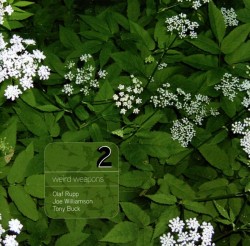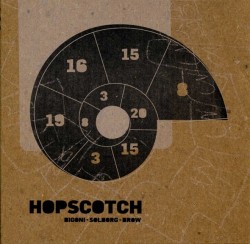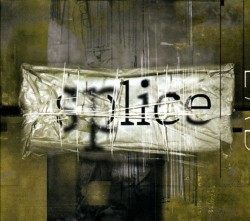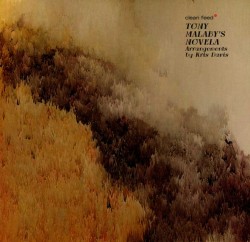 Almost from the time the professional music business was established in this country, the expected route for success has been for artists to head off to the larger market down south and set up shop there. Canadians from Percy Faith and Maynard Ferguson to Joni Mitchell and Teresa Stratas effectively followed that formula. But today, as American musical hegemony lessens and modern communications almost literally shrink the world, musicians, especially those who play improvised music, can demonstrate that a permanent home in Europe is as beneficial as becoming an American resident. Take Vancouver-born Joe Williamson for instance. On Weird Weapons 2 (Creative Sources CS197 CD www.creativesourcesrec.com), the bassist, who now lives in Stockholm after stints in London, Berlin and Montreal, is matched with German guitarist Olaf Rupp and drummer Tony Buck, an Australian turned Berliner, for two extended selections of intuitive improv. No lounge guitar trio, this band creates sonic sparks that almost visibly fly every which way. Rupp’s constant, intense strumming often elasticizes into slurred fingering as Buck buzzes drumstick on cymbals, pops his toms, door-knocks his snares and rattles and reverberates any number of bells, chains and wood blocks for additional textures. Keeping the improvisations grounded is Williamson, who splays, stretches or saws upon his instrument’s strings, scroll and body wood when he’s not creating added continuum by slapping out pedal point resonation. On the nearly 30-minute Buckram, the three reach such a level of polyphonic coherence that the cumulative textures seem to ooze into every sonic space. Moving to the forefront then fading back into the ensemble, Rupp pinpoints jagged licks that eventually accelerate to stentorian multi-string runs, as Buck concentrates pitter-pattering and agitatedly clanking into tremolo whacks. Finally, a climax is reached, as Williamson’s multi-string variations, consisting of col legno strokes vibrating with a near-electronic pulse, push the three to a decisive conclusion.
Almost from the time the professional music business was established in this country, the expected route for success has been for artists to head off to the larger market down south and set up shop there. Canadians from Percy Faith and Maynard Ferguson to Joni Mitchell and Teresa Stratas effectively followed that formula. But today, as American musical hegemony lessens and modern communications almost literally shrink the world, musicians, especially those who play improvised music, can demonstrate that a permanent home in Europe is as beneficial as becoming an American resident. Take Vancouver-born Joe Williamson for instance. On Weird Weapons 2 (Creative Sources CS197 CD www.creativesourcesrec.com), the bassist, who now lives in Stockholm after stints in London, Berlin and Montreal, is matched with German guitarist Olaf Rupp and drummer Tony Buck, an Australian turned Berliner, for two extended selections of intuitive improv. No lounge guitar trio, this band creates sonic sparks that almost visibly fly every which way. Rupp’s constant, intense strumming often elasticizes into slurred fingering as Buck buzzes drumstick on cymbals, pops his toms, door-knocks his snares and rattles and reverberates any number of bells, chains and wood blocks for additional textures. Keeping the improvisations grounded is Williamson, who splays, stretches or saws upon his instrument’s strings, scroll and body wood when he’s not creating added continuum by slapping out pedal point resonation. On the nearly 30-minute Buckram, the three reach such a level of polyphonic coherence that the cumulative textures seem to ooze into every sonic space. Moving to the forefront then fading back into the ensemble, Rupp pinpoints jagged licks that eventually accelerate to stentorian multi-string runs, as Buck concentrates pitter-pattering and agitatedly clanking into tremolo whacks. Finally, a climax is reached, as Williamson’s multi-string variations, consisting of col legno strokes vibrating with a near-electronic pulse, push the three to a decisive conclusion.
 Less than 300 kilometres southwest, in Copenhagen, lives drummer Kevin Brow, an Orangeville native and part of the trio on Hopscotch (ILK 179 CD www.ilkmusic.com), completed by Italian-born tenor saxophonist Francesco Bigoni, another Copenhagen resident, plus local guitarist Mark Solborg. Paced and cooperative, Brow’s rhythmic sensibility here is like Williamson’s on the other CD. Brow’s backbeat alternately advances or bonds the others’ extended techniques during ten notable improvisations. With Solberg’s solos including distorted power chords with rock music antecedents plus organ-like echoes, and Bigoni’s bitten-off reed strategies accelerating to intense, repetitive phraseology, the drummer’s playing creates thematic definition. Case in point is Almost. Before Brow’s hard thwacks define a conclusive tipping point where unison harmonies from the guitarist and saxist advance to similar legato patterning, the variegated strategy from each differs markedly. Solberg’s licks are trebly and echoing, while Bigoni’s behind-the-beat tones split and squeak. The percussionist can also express himself more forcefully as he does with carefully positioned press rolls and flanges on Brainwashing. Meantime the saxophonist appears to be exploring the limits of his instrument with intense vibrato, lip bubbling sprays and pressurized staccato tones, as serpentine guitar strokes harden into splayed fingering plus crunching, echoing twangs, leavened by a bit of amp buzz. Bigoni’s tone alternates among magisterial reed quivers, speech-like inflection and legato lines, which helps define the remaining tracks’ scope(s).
Less than 300 kilometres southwest, in Copenhagen, lives drummer Kevin Brow, an Orangeville native and part of the trio on Hopscotch (ILK 179 CD www.ilkmusic.com), completed by Italian-born tenor saxophonist Francesco Bigoni, another Copenhagen resident, plus local guitarist Mark Solborg. Paced and cooperative, Brow’s rhythmic sensibility here is like Williamson’s on the other CD. Brow’s backbeat alternately advances or bonds the others’ extended techniques during ten notable improvisations. With Solberg’s solos including distorted power chords with rock music antecedents plus organ-like echoes, and Bigoni’s bitten-off reed strategies accelerating to intense, repetitive phraseology, the drummer’s playing creates thematic definition. Case in point is Almost. Before Brow’s hard thwacks define a conclusive tipping point where unison harmonies from the guitarist and saxist advance to similar legato patterning, the variegated strategy from each differs markedly. Solberg’s licks are trebly and echoing, while Bigoni’s behind-the-beat tones split and squeak. The percussionist can also express himself more forcefully as he does with carefully positioned press rolls and flanges on Brainwashing. Meantime the saxophonist appears to be exploring the limits of his instrument with intense vibrato, lip bubbling sprays and pressurized staccato tones, as serpentine guitar strokes harden into splayed fingering plus crunching, echoing twangs, leavened by a bit of amp buzz. Bigoni’s tone alternates among magisterial reed quivers, speech-like inflection and legato lines, which helps define the remaining tracks’ scope(s).
 Over in the United Kingdom, the band Splice consists of two British players – trumpeter Alex Bonney and drummer Dave Smith – plus French reedist Robin Fincker who has lived in London for a dozen years, and Montreal-born Pierre Alexandre Tremblay. Tremblay, who plays bass guitar and electronics, has taught at England’s University of Huddersfield since 2005 and oversees its electronic music studio. Perhaps that’s why this disc is entitled Lab (Loop Records 1013 www.loopcollective.org). It certainly has a more extensive electronic palate than the others. Although slippery and shuddering bass guitar runs are heard infrequently throughout, Tremblay’s electronics maintain the sometimes opaque methodical pulsations which pervade the disc. A track such as The Wanderer is smooth and bouncy, built on Fincker’s chromatic clarinet runs, Bonney’s trumpet obbligatos, a shuffle drum beat and electroacoustic colouring that could be Arabic music played on an accordion. The blurry wave forms which elsewhere quiver alongside, process or complement instrumental textures such as alphorn-like vibration from Fincker’s tenor saxophone, Bonney’s brassy or muted asides and drum pops and backbeat, are more upfront on Luna Verde. Stacked horn lines, sliding bass guitar licks and percussion rebounds are accompanied by processed textures that come in-and-out of aural focus. This crackling interface concretely outlines the theme statement from the harmonized horns.
Over in the United Kingdom, the band Splice consists of two British players – trumpeter Alex Bonney and drummer Dave Smith – plus French reedist Robin Fincker who has lived in London for a dozen years, and Montreal-born Pierre Alexandre Tremblay. Tremblay, who plays bass guitar and electronics, has taught at England’s University of Huddersfield since 2005 and oversees its electronic music studio. Perhaps that’s why this disc is entitled Lab (Loop Records 1013 www.loopcollective.org). It certainly has a more extensive electronic palate than the others. Although slippery and shuddering bass guitar runs are heard infrequently throughout, Tremblay’s electronics maintain the sometimes opaque methodical pulsations which pervade the disc. A track such as The Wanderer is smooth and bouncy, built on Fincker’s chromatic clarinet runs, Bonney’s trumpet obbligatos, a shuffle drum beat and electroacoustic colouring that could be Arabic music played on an accordion. The blurry wave forms which elsewhere quiver alongside, process or complement instrumental textures such as alphorn-like vibration from Fincker’s tenor saxophone, Bonney’s brassy or muted asides and drum pops and backbeat, are more upfront on Luna Verde. Stacked horn lines, sliding bass guitar licks and percussion rebounds are accompanied by processed textures that come in-and-out of aural focus. This crackling interface concretely outlines the theme statement from the harmonized horns.
 Not surprisingly of course, the stateside lure still exists and is beneficial for some musicians. Vancouver-born, Toronto-educated pianist Kris Davis, has, after a decade in New York, become one of the go-to musicians there. While the Canadians on the other CDs may provide the backdrop for improvisations, Davis not only plays on Novela (Clean Feed CF 232 CD www.cleanfeed-records.com), by Tony Malaby’s nine-piece band, but wrote all the arrangements and conducts. A career retrospective for Malaby, Davis recasts six of his original compositions to show off his tenor and soprano saxophone prowess. The extended Remolino, for example, is given a Mexicali flavour by intertwined horn lines broadened with Dan Peck’s harsh tuba snorts and drummer John Hollenbeck’s press rolls. Dramatic chording from the pianist introduces a Malaby soprano saxophone solo which reaches an elevated level of pressurized multiphonics before downshifting to moderato timbres in unison with the other horns. Before a climax of piano key plinks and a brass fanfare, the saxophonist winds his way among clanks and scrapes from the percussionist and trombonist Ben Gerstein’s brays as close harmonies are produced by alto saxophonist Michael Attias, baritone saxophonist Andrew Hadro and Joachim Badenhorst’s bass clarinet. Carefully shaping arrangements to expose distinct sound tinctures like xylophone rhythms or plunger trombone friction, Davis makes Floral and Herbaceous another highpoint. Following trumpeter Ralph Alessi’s lead and ending with a crescendo of staccato noises, the tune plays out as a duel between Malaby’s distinctive soprano reed bites and a sequence of more muted tones from the baritone saxophonist.
Not surprisingly of course, the stateside lure still exists and is beneficial for some musicians. Vancouver-born, Toronto-educated pianist Kris Davis, has, after a decade in New York, become one of the go-to musicians there. While the Canadians on the other CDs may provide the backdrop for improvisations, Davis not only plays on Novela (Clean Feed CF 232 CD www.cleanfeed-records.com), by Tony Malaby’s nine-piece band, but wrote all the arrangements and conducts. A career retrospective for Malaby, Davis recasts six of his original compositions to show off his tenor and soprano saxophone prowess. The extended Remolino, for example, is given a Mexicali flavour by intertwined horn lines broadened with Dan Peck’s harsh tuba snorts and drummer John Hollenbeck’s press rolls. Dramatic chording from the pianist introduces a Malaby soprano saxophone solo which reaches an elevated level of pressurized multiphonics before downshifting to moderato timbres in unison with the other horns. Before a climax of piano key plinks and a brass fanfare, the saxophonist winds his way among clanks and scrapes from the percussionist and trombonist Ben Gerstein’s brays as close harmonies are produced by alto saxophonist Michael Attias, baritone saxophonist Andrew Hadro and Joachim Badenhorst’s bass clarinet. Carefully shaping arrangements to expose distinct sound tinctures like xylophone rhythms or plunger trombone friction, Davis makes Floral and Herbaceous another highpoint. Following trumpeter Ralph Alessi’s lead and ending with a crescendo of staccato noises, the tune plays out as a duel between Malaby’s distinctive soprano reed bites and a sequence of more muted tones from the baritone saxophonist.
Whether it’s as co-leader, arranger, teacher or improviser, each of these Canadians appears to have found the proper foreign context for his or her musical development.



